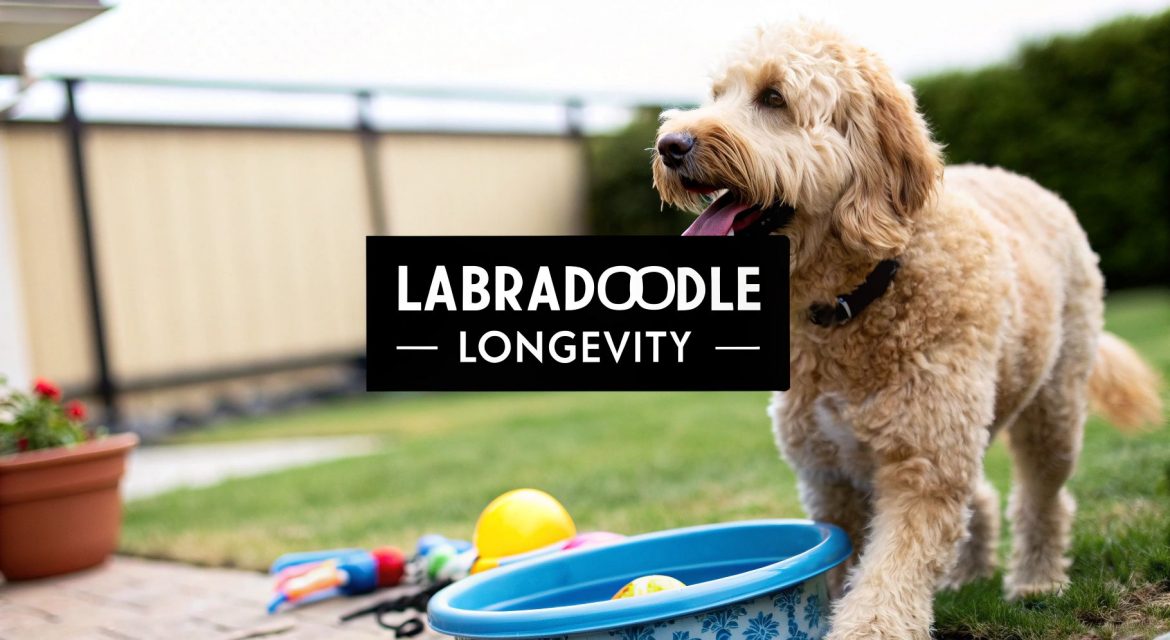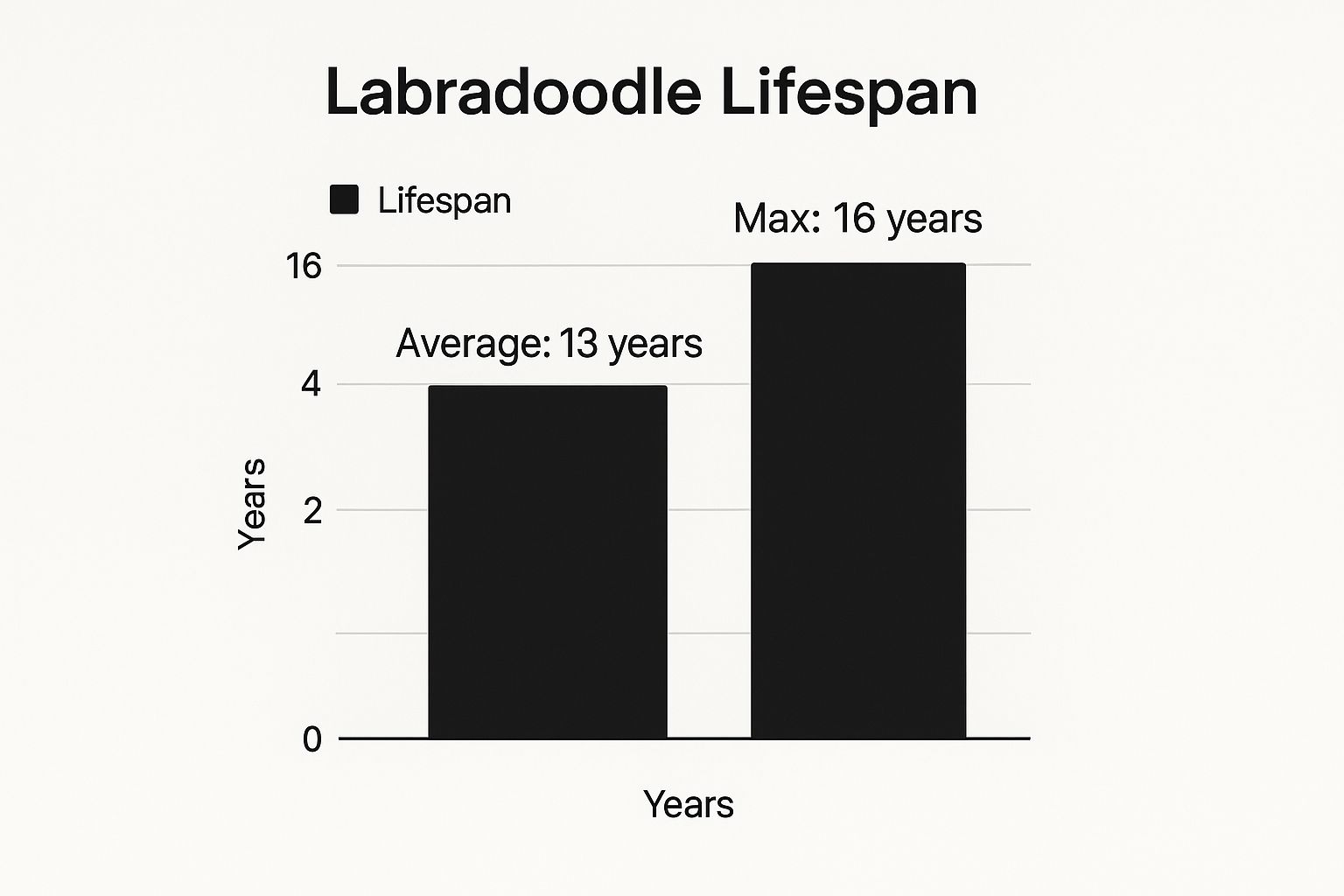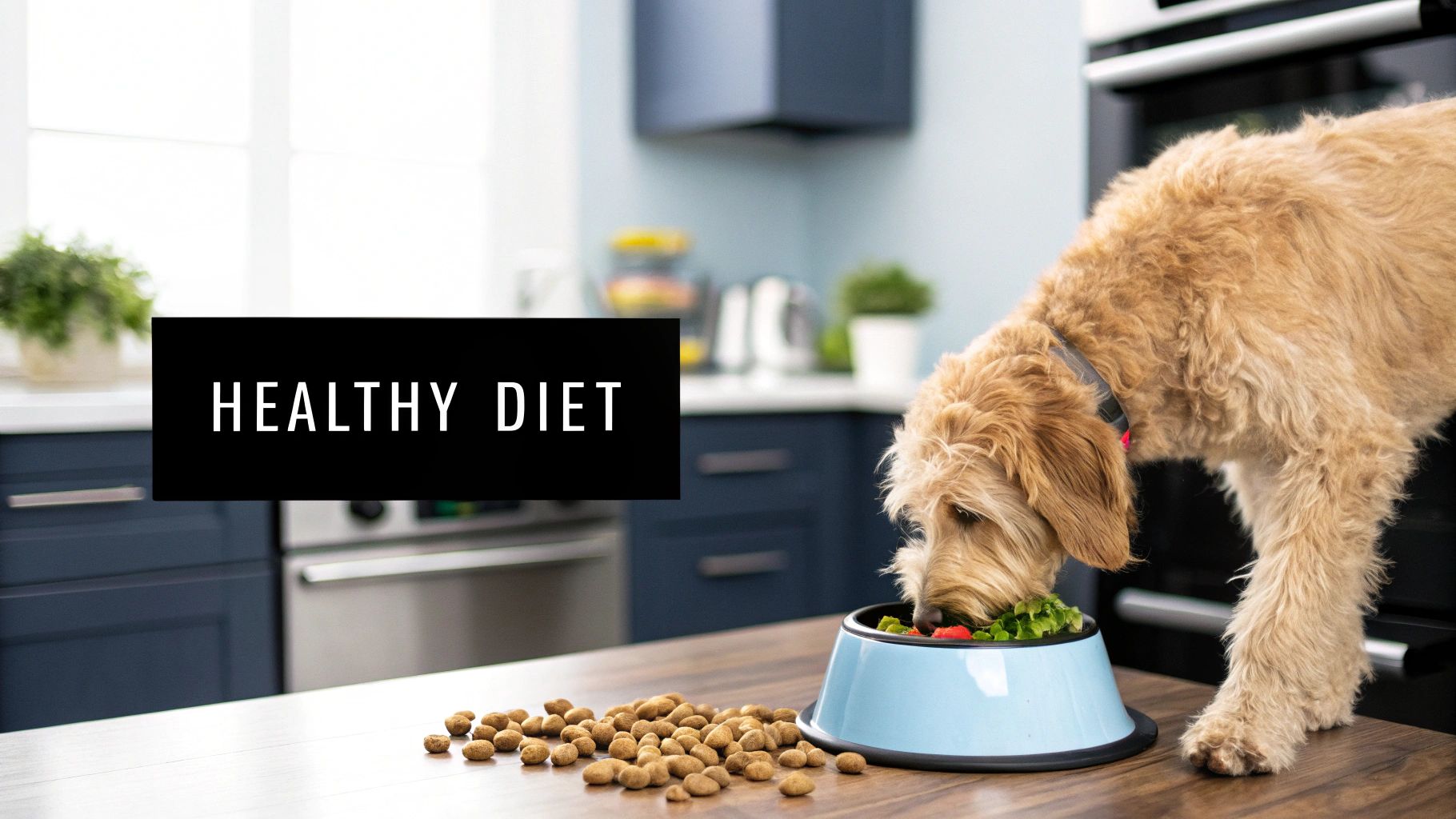Bringing a Labradoodle into your life is such an exciting decision, and one of the first questions on your mind is probably, "how long will my furry friend be with me?" It's a question that comes from a place of love, and we're here to walk through it with you. You can generally expect your wonderful companion to be part of your family for a good 12 to 15 years.
This reassuringly long lifespan is just one of the many reasons these dogs make such incredible family members, and we want to help you make every one of those years count.
Unpacking the Labradoodle Lifespan
Welcoming a Labradoodle into your home is a long-term commitment, and knowing what to expect helps you prepare for all the joyful years ahead. As a cross between a Labrador Retriever and a Poodle, they often get the benefit of something we call 'hybrid vigour'.
Put simply, this means that mixing the genetics of two different purebreds can sometimes result in a healthier, more robust dog than either of the parent breeds might be on their own. It's a little genetic advantage that we can build on with great care.
Of course, not all Labradoodles are created equal, and their size plays a surprisingly big role in their longevity. It's a well-known fact in the dog world that smaller dogs generally live longer than their larger cousins, and this holds true for our Doodles.
The image below gives you a quick visual of the typical age range for this fantastic breed.
As you can see, while 13 years is a solid average to expect, reaching 16 is absolutely on the cards when you provide top-notch, loving care.
Labradoodle Lifespan by Size
Here’s a quick look at how a Labradoodle's size, which is influenced by their Poodle parent, can affect the lifespan you can hope for.
| Labradoodle Size | Typical Lifespan Range (UK) |
|---|---|
| Miniature | 14 – 15 years |
| Medium | 13 – 15 years |
| Standard | 12 – 14 years |
It's clear that the smaller the Doodle, the more birthdays you're likely to celebrate together. But please remember, these are just averages—so many factors, especially the love and care you provide, can nudge these numbers up or down.
What Shapes Their Years?
So, what's the secret sauce to a long and happy Doodle life? It really comes down to a mix of good genes and great daily care from you.
Here in the UK, the consensus among vets and long-time owners is that a combination of a balanced diet, regular vet check-ups, and plenty of mental stimulation is the key. These things work together to help our Labradoodles reach, and sometimes even exceed, the upper end of their age range. For a deeper dive, UK pet care experts at Waggel.co.uk have some excellent insights into the factors that influence their longevity.
How Genetics and Size Shape Their Health
Have you ever noticed how smaller dogs often seem to stick around longer than their giant pals? It's a curious thing, and the answer is a fascinating mix of genetics and simple biology. When it comes to how long your Labradoodle will be with you, their unique family tree—part loyal Labrador Retriever, part clever Poodle—plays a massive part in their overall health.
This genetic mash-up is often a real advantage. The combination can create something called 'hybrid vigour,' which is a bit like getting the best of both worlds. It can potentially lower the risk of some hereditary conditions that are common in purebreds. We can think of it as diversifying their genetic portfolio, which often results in a tougher, more resilient companion for you.
The Role of Their Parents
The health and lifespan of your Labradoodle are directly tied to the health of their parents. A good, responsible breeder will always screen for common health problems found in both Labradors and Poodles, giving the puppies the best possible start in life. That's why having a peek into their family history is so important for their future with you.
A major UK veterinary study offers a great benchmark, noting that the median lifespan for Labrador Retrievers is 13.1 years. Since Labradoodles get half their DNA from Labs, this figure gives us a solid clue about their own potential and backs up the realistic expectation of a 12-15 year lifespan.
That same study also found that mixed-breed dogs, like our beloved Doodles, often live longer than their purebred counterparts. It also highlighted that smaller dogs tend to live longer. Because Labradoodles have the longer snouts of their parent breeds—avoiding many of the health issues we see in flat-faced dogs—their genetic makeup really does set them up for a good, long life. You can dig into more of these fascinating findings in the comprehensive UK vet study.
Why Smaller Doodles Often Live Longer
The size differences we see across Labradoodles—from the little miniatures to the big standard ones—all come from their Poodle heritage. It’s a simple truth in the dog world that larger dogs tend to age more quickly. Their bodies just have to work harder, which puts more strain on their vital organs over the years.
This means a Miniature Labradoodle might well get to enjoy a few more years with you compared to a Standard Labradoodle. It’s not a cast-iron guarantee, of course, but it’s a key factor. Understanding this genetic lottery helps us appreciate our dog's individual needs and support them for the longest, happiest life possible.
Common Health Issues to Be Aware Of
Part of being a great dog owner is knowing what potential health challenges you and your dog might face together. Being aware of these possibilities isn't about worrying; it’s about being prepared so you can be your Labradoodle's strongest health advocate.
Because Labradoodles are a mix of Labradors and Poodles, they can inherit health conditions from either side of the family. While hybrid vigour often reduces these risks, it’s still wise for us to know what to look for. Think of it like knowing your own family's health history—it empowers you to make proactive choices for your friend.
Your first line of defence is always choosing a responsible breeder. A great breeder will conduct thorough health screenings on the parent dogs for known hereditary issues, which significantly lowers the chances of puppies developing these problems later on.
Key Conditions to Monitor
While Labradoodles are generally a robust mix, there are a few specific conditions they can be prone to. We've explained them here without the confusing medical jargon, so you know exactly what signs to watch for.
- Hip and Elbow Dysplasia: This is essentially a malformation of the joint that can lead to arthritis down the line. If you notice your dog seems stiff, has trouble getting up, or is reluctant to jump or use stairs, it’s worth a chat with your vet.
- Eye Conditions: Issues like Progressive Retinal Atrophy (PRA) can be inherited. Early signs might be subtle, such as bumping into things in low light or being hesitant when it gets dark.
- Addison's Disease: This is a hormonal disorder that can be tricky to diagnose because its symptoms, like lethargy and a poor appetite, are quite general. Regular vet check-ups are brilliant for helping catch conditions like this early.
Knowing the early signs of potential issues is one of the most powerful tools you have. An early conversation with your veterinarian can turn a small concern into a manageable treatment plan, ensuring your companion stays comfortable and happy for years to come.
Understanding these possibilities helps you provide the best care throughout your dog's life, especially as they enter their golden years. For more guidance, you can explore our detailed article on common senior dog health issues to feel even more prepared.
Practical Ways to Extend Your Labradoodle's Life
Genetics play a part, but they don't tell the whole story. You have a huge influence on your dog's health and happiness every single day. Knowing the average Labradoodle lifespan is one thing; making daily choices that boost it is where you and I can make a real impact.
Think of the next few years as a partnership. Let's look at the simple, practical things you can do to give your best friend the longest, most vibrant life possible.
We're going to break it down into four key areas you can control: what they eat, how they move, how you keep their minds sharp, and staying one step ahead with preventative health. A little bit of attention in each of these areas builds a powerful foundation for a long and joyful life together.
Nourishment for a Long Life
Just like with us, what goes into your Labradoodle's bowl has a direct line to their energy levels, overall health, and how long they'll be with you. Feeding them a high-quality, balanced diet that’s right for their age—whether they're a tiny puppy, a full-on adult, or a graceful senior—is one of the most important things we can do.
A great diet does more than just fill their tummy. It's your number one tool for maintaining a healthy weight, which is critical for protecting their joints from unnecessary stress and slashing the risk of arthritis down the line. Honestly, keeping your Doodle lean is one of the kindest things you can do for their long-term health.
Keeping a dog at an ideal body weight can extend their life by up to two years. This simple act of portion control and choosing quality food is one of the most effective anti-ageing strategies you can implement.
Active Bodies and Bright Minds
Labradoodles are the product of two incredibly smart and energetic breeds. That means they need a good run-around for their bodies and plenty of stimulation for their brains to be truly happy. A bored dog often becomes a stressed or destructive one, so keeping their mind ticking over is just as vital as their daily walk.
A solid exercise plan should be consistent, but we also need to be mindful of their joints. They absolutely love a good run, but low-impact activities like swimming or scent work are fantastic for giving them a workout without the wear and tear.
When it comes to mental enrichment, you don't need to spend a fortune on fancy gadgets. The simple things often work best:
- Puzzle Toys: These turn mealtimes into a fun challenge and get their problem-solving gears turning.
- Training Games: A few short, fun training sessions each day not only reinforce good manners but also strengthen that incredible bond you share.
- New Smells: Just taking a different route on your walk opens up a whole new world of information for their powerful nose.
By nurturing both their body and their mind, you're helping to keep them feeling youthful, engaged, and happy. If you're looking for more wellness ideas, you can find a wealth of information in our complete guide to dog health and care. It's a fantastic resource for building these healthy habits from the ground up.
The Financial Side of a Long and Healthy Life
Bringing a Labradoodle into your life is an incredible experience, but it’s a journey that’s best started with a clear financial picture. When we ask ourselves how long do Labradoodles live, we also need to think about the investment that helps them enjoy those golden years to the fullest.
This commitment goes well beyond what you first pay for your puppy. It's an ongoing promise to their health and happiness, covering everything from high-quality food to fuel their adventures, to regular grooming for their unique coat, and routine vet checks to catch any potential issues early.
Budgeting for a Happy Companion
In the UK, you can expect the initial cost of a well-bred Labradoodle puppy to fall somewhere between £800 and £2,500. After that, the ongoing monthly costs for essentials like premium food and grooming usually land between £60 and £90. Knowing these figures upfront helps you prepare for a lifetime of happy, responsible ownership. The experts over at Napo.pet break down these financial realities in more detail.
Investing in your Labradoodle's health is one of the most direct ways to influence their longevity. A proactive approach to their care, supported by a realistic budget, ensures you're always ready to give them what they need to thrive.
Of course, life can throw us a curveball, and unexpected health problems can pop up at any age. This is where pet insurance really proves its worth. It acts as a crucial financial safety net, meaning you can make decisions based on what’s best for your dog, not just what’s in your bank account. For our older dogs, the right cover is particularly important. To get a better handle on your options, take a look at our guide on dog insurance for senior dogs.
By planning for these costs, you can provide consistent, high-quality care without the stress, making sure every single year with your beloved companion is a healthy and happy one.
Your Labradoodle Longevity Questions Answered
We know you've got questions, and we're here with the answers. As you plan for a long, happy life with your furry friend, it’s completely normal for specific queries to pop up. This section is all about giving you clear, straightforward advice to help you feel even more confident in caring for your dog through every stage of life.
We've gathered some of the most common questions from Labradoodle owners across the UK. Think of this as your go-to reference for those finer details.
Do Female Labradoodles Live Longer Than Males?
This is a question we hear a lot, and the answer is quite interesting. While some huge studies show a very slight longevity advantage for female dogs across many breeds, the difference is generally tiny—often just a few months.
For your own Labradoodle, factors like their genetics, the quality of their day-to-day care, and whether they have been neutered will have a much bigger impact on how long they live than their sex will.
What Are the Signs My Labradoodle Is Becoming a Senior?
It’s a real milestone in your journey together when your lively doodle starts entering their golden years. You might begin to notice some gentle signs of ageing around age eight or nine.
Look for subtle changes like a touch of grey around their muzzle, sleeping a bit more soundly, or maybe taking a moment longer to get up after a nap. You might also spot slight changes in their hearing or vision.
These are all normal parts of the ageing process. The best thing you can do is partner with your vet for regular senior wellness check-ups. This proactive approach helps you manage these changes gracefully and keep your friend comfortable and happy.
How Does Neutering or Spaying Affect Their Lifespan?
Making the decision to neuter or spay your Labradoodle is a key part of responsible ownership here in the UK. Generally speaking, the procedure is strongly linked to a longer, healthier life for your dog.
It significantly reduces or completely eliminates the risk of developing certain reproductive cancers, which is a massive health benefit. On top of that, it can help prevent behaviours like roaming, which could lead to accidents or injuries. Most UK vets recommend it as a cornerstone of preventative health that contributes positively to their overall well-being and lifespan.
At My Life My Dog, we believe that knowledge is the key to a deeper bond with your dog. For more expert advice on every stage of your dog's life, from puppyhood to their senior years, explore our extensive guides at https://mylifemydog.com.









